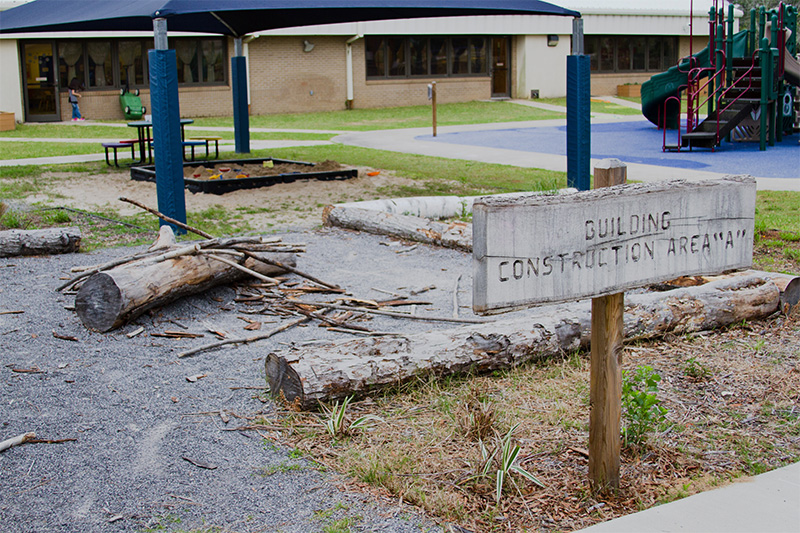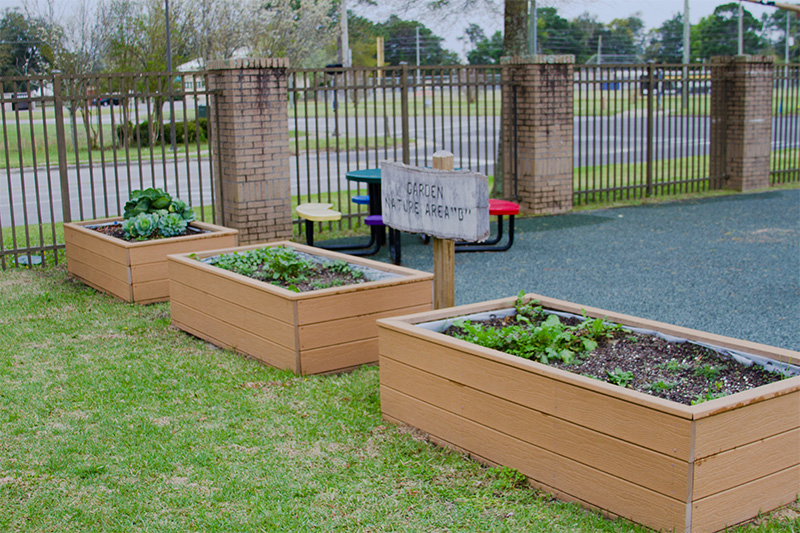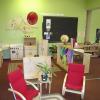- Teach staff members the importance of viewing the outdoors as an extension of the learning environment.
- Provide staff with the resources to effectively use the outdoors as an integral and rich learning environment across the curriculum.
- Model ways to organize outdoor spaces into interest areas that meet the needs of all children.
- Provide feedback on outdoor learning environments.
Learn
Teach
Children’s experiences in nature and the outdoors support many aspects of their development (see the attachment in the “Learn” section for more information). In many programs, children spend as much as two hours per day outdoors. This is valuable time for children to develop their large muscles and sophisticated play skills. Much of what is done indoors can be easily adapted to the outdoor environment. There are four key considerations for working with staff as they make the outdoors an integral and rich learning environment for children ages birth through 12 years: Safety, Design, Space, and Accessibility. These four considerations are discussed in depth here.
Safety
Evaluate the outdoor environments regularly. Work with staff to make sure they do their own daily safety inspections before children use the space. Make sure the equipment is safe and the environment is free from preventable risks. You must consider fall zones, surfacing, access to shade, and the condition of materials and equipment. See the Safety lesson for more information. When you have concerns about the environment or children’s safety, address them immediately with the staff or management.
Design
Outdoor spaces can offer many of the same interest areas and activities as are typically offered indoors in the child-development or school-age programs. For child-development programs, you might encourage staff to include sand, water, wheeled toys, games, construction, woodworking, quiet activities, science, and nature in their outdoor spaces (Colker, Dodge, & Heroman, 2004). For school-age programs, the addition of gardening, sports, fitness equipment, music, and natural habitats for exploration can help children learn beyond the school day.
Just as in the classroom or school-age program, staff must make sure outdoor spaces are organized for independence, easy use, and learning. During your observations, it is important for gross-motor play to happen safely in one area without disrupting activities in another area. For example, a basketball game should not play through children who are drawing with chalk. You also want to ensure quiet activities (art, chalk, blocks, sand, reading under a tree) are separate from loud and active activities (ball play, bikes, running).

Space
As a trainer or coach, you can help staff make the most of the space they have. Not all outdoor spaces are ideal, but that doesn’t mean you have to settle for a playground with only metal play structures and asphalt. You can help staff brainstorm and get creative. Your local home improvement store can be a great resource. Consider helping staff members fill plastic rain gutters with dirt and letting children use them as planters or sensory bins. Wading pools can become sand boxes or planters. Ask for volunteers to install bird feeders or raised garden beds. Recycled cardboard boxes, crates, PVC pipes, and milk cartons can all become amazing construction objects on the playground. Also look into resources your organization can share with staff and families. The U.S. Fish and Wildlife Service’s handbook on creating schoolyard habitats is a great example https://www.fws.gov/cno/conservation/Schoolyard.html and https://www.fws.gov/cno/pdf/HabitatGuideColor.pdf

Accessibility
There are two aspects to accessibility: (1) children have access to resources they need outdoors and (2) the environment is accessible to all children.
First, make sure children's basic needs are met outdoors. Ensure access to restrooms, drinking water, and shade.
Second, consider the needs of individual children. Some children, especially those with disabilities or special needs, may have difficulties in the outdoor environment. Equipment may be inaccessible to children with motor impairments, the area may be frightening to children with visual impairments, or the amount of choice may be overwhelming to children with developmental delays. You can help staff make adaptations for these children just as you would in the classroom or program. This will be covered in more depth in Lesson Six.
Model
Just like with indoor environments, you should have an active role in making sure the outdoor environments provide a foundation for the curriculum. Help staff members make the most of the space you have. Spend time outdoors observing how children and adults use the space. Then get involved in helping make the space meet children’s needs. For example, you could:
- Organize a campaign to ask for donations of materials for a garden, dramatic play area, stage, or natural habitat.
- If your climate permits during some or all seasons, consider developing an outdoor classroom. Try flipping your approach to weather: only go indoors during inclement weather!
- Ensure there are plenty of outdoor storage spaces for supplies and equipment. Model cleanliness habits by keeping the storage and play spaces tidy.
- Ask children questions about their outdoor play. Involve older children in identifying problems and coming up with solutions.
- Advocate to program leaders for outdoor play spaces and for time in the outdoors for all children and staff.
- Talk to staff and families about the importance of outdoor spaces.
- Look at the environment first when there is challenging behavior. Observe children and help staff members recognize when there is too much or too little structure, too much or too little challenge, or too much or too little direction for play.
Just as with indoor spaces, model curiosity and problem solving as you work with staff members. When a space needs arranging or rearranging, help staff members list all the activities, events, and materials that the space should accommodate. Use that list to set goals for the space and clearly define spaces that serve different functions. Also, keep open lines of communication across staff members who work different shifts in the same space. It is important that all staff members understand the purposes behind environmental arrangement. If outdoor spaces are shared between classrooms, open the lines of communication among all adults who share the space. Sometimes you might need to facilitate cooperation and negotiation about shared outdoor learning spaces.
Observe
All staff members have different needs, perspectives, and experiences. Each will use the outdoor space differently. Match your coaching to each individual staff member.
It is your responsibility to ensure that staff members provide high-quality, engaging environments indoors and out. You should observe staff members and talk with them about the strengths and challenges of the outdoor space. For many programs, you will not have much flexibility in terms of changing the space itself; rather you will need to support staff members as they learn to use the space appropriately and maximize its potential.
Let's begin by taking a look at an outdoor environment.
Case Example: Outdoor Learning Environment
Case Example Step 1: Make a Plan
Here we see a well-maintained outdoor play space. There are a variety of areas for play and lots for the children to do. However, while observing, the trainer or coach noticed that children were playing unsafely with balls and missing out on learning opportunities. The trainer or coach and the teacher made a plan to help children maximize learning.
Goal: To offer at least five interesting learning environments outdoors each day.
Steps to reach the goal:
- Observe outdoors and identify hot spots where children seem bored or have a hard time following safety rules. Person responsible: Trainer or coach. Timeline: Immediately and share information during meeting on Thursday.
- Brainstorm at least 10 options we could provide to children and make sure five are always available. Initial list of new activities includes dramatic play, building blocks, and nature observations. Post brainstorming sheet in staff space, so staff on all shifts can add ideas. Timeline: Next week.
- Include outdoor learning environments on each weekly plan and provide to trainer or coach for review and feedback. Person responsible: Classroom leads. Timeline: Weekly.
- Introduce children to the new play ideas before going outside. Person responsible: Classroom staff member on duty. Timeline: Daily beginning next week.
- Observe and collect data on how children use the new activities. Person responsible: Classroom staff and trainer or coach. Timeline: Weekly beginning once all new environments have been introduced once.
Case Example Step 2: Provide Feedback
After observing this play space, the trainer or coach might say things like:
- I noticed how responsive all of the teaching staff were to the children’s needs: you brought out basketball hoops, sand tables, bubbles, and more to help keep children engaged in interesting things.
- I noticed the children were taking the balls onto the play structure today. How do adults respond when that happens?
- Why do you think the children want to take the balls on the play structure? What experiences are they having there?
- While I was observing, it looked like the balls were being used as part of chase games and pretend play. What do you think we could offer the kids that would let them get those experiences safely?
- What props or materials would be ok to use on the structure? Or could we define another area where kids can use materials in interesting ways safely (dramatic play)?
- What about the ball area makes it likely that children will take the balls out of that area? Is that always a problem?
- Let's brainstorm some ways to set up the ball area, so the children are more likely to keep the balls in the safe area and to play for longer periods of time.
- Let's brainstorm ways to help the kids use materials in interesting but safe ways. Maybe we could develop some ramps or other structures that are ok for children to use balls.
Case Example Step 3: Provide Resources
As a trainer or coach, you can provide resources that help staff members do their jobs more confidently and more effectively. In this example, the trainer or coach might help teachers look online for outdoor play ideas. She or he might provide resources from their curriculum or learning library. She or he might help them find the resources to create a dramatic play area or a creative ramp area outdoors.
Additional Examples of Outdoor Environments
As a trainer or coach, you will likely see a range of environments across a range of age groups. Watch the following videos to see examples of high-quality outdoor environments. Think about how you could work with staff to offer the kinds of experiences seen here.
A Range of Outdoor Learning Environments
Explore
Sometimes a playground isn’t perfect. It’s still very important that the outdoor space become an extension of the learning environment. Watch this video from a program that has made the most of its outdoor space. What can you learn from this program? What could you help staff members implement in your program?
Use the Learning from Others activity to think about your own program as you watch the video. Then answer the questions and review them with the Suggested Responses provided.
Learning from Others
Apply
Use the following Outdoor Learning Environment Inventory: Child Development Programs to help you evaluate outdoor learning environments for child-development and school-age programs.
Glossary
Demonstrate
Children & Nature Network. (2019). Tools & Resources. Retrieved from https://www.childrenandnature.org/learn/tools-resources/
Cryer, D., Harms, T., & Riley, C. (2003). All About the ECERS-R: A detailed guide in words and pictures to be used with the ECERS-R. Lewisville, NC: Kaplan Early Learning Co.
Dodge, D. T., Colker, L. J., & Heroman, C. (2002). The Creative Curriculum for Preschool (4th ed.). Washington, DC: Teaching Strategies, Inc.
Let's Move Outside. Retrieved from https://letsmove.obamawhitehouse.archives.gov/lets-move-outside
Let's Move: America's Move to Raise a Healthier Generation of Kids. https://letsmove.obamawhitehouse.archives.gov/
Sanders, S. (2002). Active for Life: Developmentally appropriate movement programs for young children. Champaign, IL: Human Kinetics Publishers.
Shillady, A. (n.d.). Spotlight on Young Children and Nature. Washington, DC: National Association for the Education of Young Children.
U.S. Department of the Interior. America's Great Outdoors: Youth. Retrieved from https://obamawhitehouse.archives.gov/administration/eop/ceq/initiatives/ago
U.S. Fish & Wildlife Service. (2018). Schoolyard Habitat Program. Retrieved from https://www.fws.gov/cno/conservation/Schoolyard.html
U.S. National Park Service. (n.d.). Kids in parks. Retrieved from https://www.nps.gov/kids/index.cfm
Video Active Productions (n.d.). Safe Active Play: A Guide to Avoiding Play Area Hazards (DVD). Washington, DC: National Association for the Education of Young Children.
Youth in the Great Outdoors. Retrieved from https://training.fws.gov/programs/education-outreach/YGO-Annual-Report-2015.pdf


